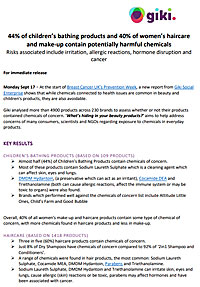 |
|
Children’s Bathing Products And Women’s Haircare And Make-Up The bad news: Researchers have found more than 300 chemicals in the umbilical cord blood of newborn babies, rendering them pre-polluted even before birth.Plus, 44% of children’s bathing products and 40% of women’s haircare and make-up contain potentially harmful chemicals with the associated risks including irritation, allergic reactions, hormone disruption and cancer
Giki analysed more than 4900 products across 230 brands to assess whether or not their products contained chemicals of concern. Key Results: Children’s Bathing Products (Based On 109 Products) Almost half (44%) of Children’s Bathing Products contain chemicals of concern. Most of these products contain Sodium Laureth Sulphate which is a cleaning agent which can affect skin, eyes and lungs. DMDM Hydantoin, (a preservative which can act as an irritant), Brands which performed well against the chemicals of concern list include Attitude Little Ones, Child’s Farm and Good Bubble. Overall, 40% of all women’s make-up and haircare products contain some type of chemical of concern, with more chemicals found in haircare products and less in make-up. Haircare (Based On 1418 Products) Three in five (60%) haircare products contain chemicals of concern. A range of chemicals were found in hair products, the most common: Sodium Laureth Sulphate, Cocamide MEA, DMDM Hydantoin, Parabens and Triethanolamine. Sodium Laureth Sulphate, DMDM Hydantoin and Triethanolamine can irritate skin, eyes and lungs, cause allergic (skin) reactions or be toxic. Parabens may affect hormones and have been associated with cancer. Urtekram, Roots & Wings and Organic Shop consistently performed well, with none of their products containing chemicals of concern. Make-Up (Based On 3377 Products) Almost three quarters (71%) of women’s make-up (Blushers, Lipsticks and Glosses, EyeØ Make-Up and Foundation) is free from chemicals of concern. The most common types of chemicals of concern found in make-up products include BHT, Parabens and Ethylhexyl Methoxycinnamate. While BHT can irritate skin, eyes and lungs and may be toxic to organs, parabens andØ Ethylhexyl Methoxycinnamate are both associated with endocrine disruption. Burts Bee’s, La Roche-Posay, Miss Sporty, Bourjois, Rimmel London and George (Asda)Ø performed best. Very few brands produce an entire range which is free from chemicals of concern.
“Often we have no idea whether the products we are using contain chemicals of concern. However, as consumers, we do have a choice. There are other options which are just as good and don’t contain chemicals we might want to avoid for us or our family. It’s just a matter of finding them – and Giki wants to make that easier for us all.” What Are Chemicals Of Concern? Understanding the ingredients list on most cosmetics is difficult for the vast majority of people. Not only are the terms often highly scientific but there are also a large number of terms to understand. Whilst the amount of exposure, the length of exposure, other factors and uncertainty make it almost impossible to determine a direct link to issues from skin irritations and allergic reactions to links to cancer, hormone disruption and effects on the reproductive system, many consumers take the approach that they would rather not take the risk. As a result Giki has compiled a list of commonly cited chemicals of concern using a number of sources. These are the Campaign for Safe Cosmetics (a US based not-for profit), Breast Cancer UK (#ditchthejunk) and the David Suzuki Foundation (a Canadian charity). This list can never be fully comprehensive or complete so consumers should always check the label if there is a particular ingredient they are concerned about. Giki’s algorithms read the product label looking for the chemicals and, if none are found, a product is awarded a No Chemical of Concern badge. About Giki Giki, a social enterprise, was founded in 2017 to encourage sustainable consumption by inspiring people to make small, regular changes in their supermarket shopping which are good for them, better for the environment and fairer to other. We do this by rating over 250,000 supermarket products on sustainability, health and fairness. This information is delivered via a free app, which is available from www.gikibadges.com Source: Giki Press Release
|
|
|
 At the start of Breast Cancer UK’s Prevention Week ion 2018, a new report from Giki Social Enterprise showed that while chemicals connected to health issues are common in beauty and children’s products, they are also avoidable.
At the start of Breast Cancer UK’s Prevention Week ion 2018, a new report from Giki Social Enterprise showed that while chemicals connected to health issues are common in beauty and children’s products, they are also avoidable.  Jo Hand, Co-founder at Giki, commented:
Jo Hand, Co-founder at Giki, commented: